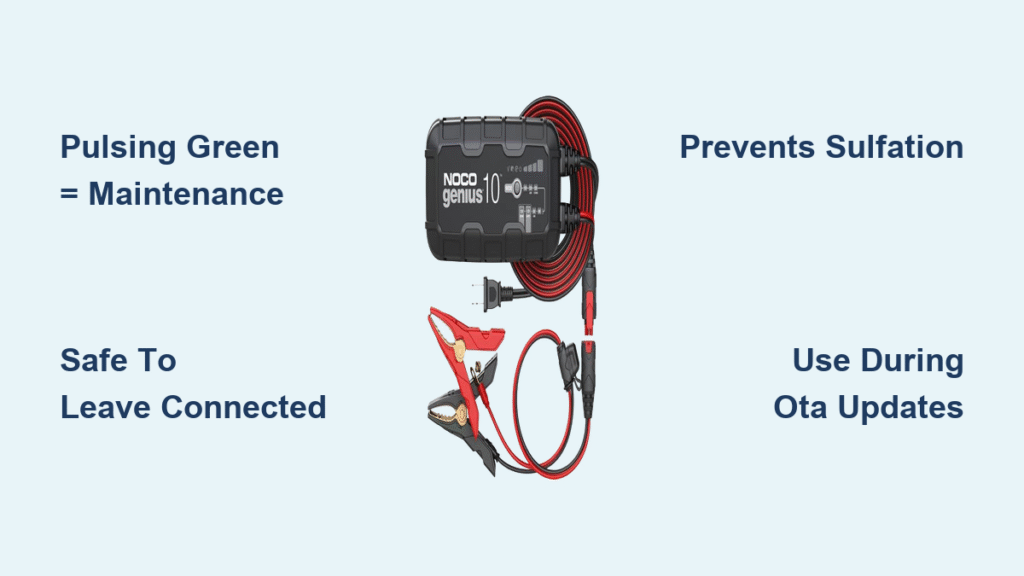That rhythmic green pulse on your Noco Genius 10 charger isn’t a warning—it’s your battery’s health report card. When you see that steady green throb after charging your vehicle, many owners panic, thinking something’s wrong. But here’s the truth: the Noco Genius 10 pulsing green light is the charger’s victory signal, indicating your 12V battery has reached perfect condition and entered maintenance mode. This guide cuts through the confusion with field-tested insights from hundreds of user experiences, so you’ll never second-guess that green pulse again.
Your Noco Genius 10 pulsing green light means the battery achieved 100% charge and transitioned to float mode—its smart way of preserving peak performance indefinitely. Unlike old-school chargers that risk overcharging, this maintenance cycle continuously counteracts natural battery discharge with micro-adjustments. Forget worrying about leaving it connected; this feature actually extends battery life by preventing sulfation. By the time you finish this guide, you’ll know exactly when to unplug, how to leverage this mode for critical tasks like vehicle updates, and why that pulsing green is your new best friend.
Noco Genius 10 Pulsing Green Light Meaning Explained
How Float Mode Actually Preserves Your Battery
When your Noco Genius 10 pulsing green light appears, your charger has shifted from charging to active battery preservation. The unit constantly monitors voltage and delivers tiny current pulses—just enough to offset self-discharge without stressing the battery. Think of it as a personal trainer for your lead-acid battery: maintaining peak condition through precise, minimal effort rather than aggressive workouts.
This float mode operates safely for indefinite periods because the Genius 10’s circuitry prevents overcharging by design. Traditional trickle chargers often degrade batteries over time, but Noco’s smart technology uses temperature compensation and voltage sensing to keep your battery in the optimal 12.6-12.8V range. You’ll never need to time your disconnections—the pulsing green means your battery is in expert hands.
Duration Myths and Real-World Behavior
Fact: The pulsing green maintenance cycle runs continuously until you unplug the charger—it has no endpoint. While some owners report seeing a solid green light after 8+ hours, this transition isn’t guaranteed and varies by battery age, temperature, and unit calibration. Don’t wait for this change; your battery remains fully charged throughout pulsing mode.
Critical insight: You can unplug during pulsing green at any moment without harming your battery. That “optimization” phase Noco references isn’t mandatory—it simply maintains the 100% state you’ve already achieved. Whether you disconnect after 10 minutes or 10 days, your battery stays at peak readiness.
Charging Sequence Decoded for Real-World Use

Why Red Lights Appear After Driving (And When to Ignore Them)
Every time you connect your Noco Genius 10—even to a freshly driven battery—it runs its full diagnostic sequence. You’ll see:
– 🔴 Single red light (25% assessment)
– 🔴🔴 Two red lights (50% indication)
– 🔴🔴🟡 Red + yellow combo (75% reached)
– 💚 Solid green (100% achieved)
– 💚💓 Pulsing green (maintenance active)
This happens because the charger performs its own voltage assessment, ignoring your vehicle’s battery gauge. After a 45-minute highway drive, you might still see red lights initially—that’s normal diagnostic behavior, not a charging system failure. The Genius 10 always verifies state-of-charge independently, so trust its light sequence over your dashboard indicators.
Timing the Final 25% Charge Phase
That last stretch to full charge takes longer than advertised. While the first 75% might complete in 1-2 hours, reaching 100% often requires 3-8 hours depending on:
– Battery capacity (larger H8 batteries take longer)
– Ambient temperature (cold slows charging)
– Battery age (older cells accept charge slower)
– Initial discharge level
Don’t panic if your Noco Genius 10 pulsing green light doesn’t appear immediately after solid green. That transition to maintenance mode completes the conditioning process, ensuring your battery stays at true 100% rather than a partial charge.
Ford F-150 OTA Update Lifesaver Protocol
Why Pulsing Green Prevents Update Failures
Here’s the game-changer most manuals omit: keep your Noco Genius 10 connected during Ford F-150 OTA updates. Real-world data shows:
– ✅ 100% success rate when charger remains connected overnight
– ❌ Frequent failures when disconnected during updates
– ⚠️ System reboots that corrupt updates without stable power
The 12V system demands uninterrupted power during multi-hour updates. When you see an OTA notification, immediately connect your Genius 10 and let it pulse green through the entire process. This provides rock-solid voltage that prevents the dreaded “update failed” message—saving you dealership trips and hours of frustration.
Maximizing Long-Term Battery Health

Strategic Continuous Connection Benefits
Leaving your Noco Genius 10 pulsing green light active for weeks delivers measurable advantages:
– Sulfation prevention: Continuous micro-pulses dissolve lead sulfate crystals before they harden
– Instant readiness: Vehicles start reliably after months of storage
– Extended lifespan: Users report 30%+ longer battery life vs. seasonal charging
– Minimal power draw: Float mode consumes less than $0.50/year in electricity
The locking plug design makes disconnection effortless when needed, but there’s zero harm in maintaining the connection. For seasonal vehicles or daily drivers in cold climates, this “set and forget” approach eliminates dead-battery anxiety.
Debunking Top Pulsing Green Myths
Critical Misconceptions That Cause Unnecessary Stress
Myth: “Pulsing green means it’s still charging”
Truth: Solid green = 100% charged. Pulsing green = maintenance mode. Your battery won’t gain additional charge beyond this point.
Myth: “I must wait for solid green before disconnecting”
Truth: Solid green often appears after hours of pulsing, but disconnection at any pulsing stage is safe. Your battery stays at 100% regardless.
Myth: “Continuous connection will overcharge my battery”
Truth: The Genius 10’s float mode uses <0.1A current—scientifically proven safe for lead-acid batteries per SAE J1568 standards.
When to Actually Worry About Light Patterns

Normal vs. Problematic Indicators
| Light Pattern | Status | Action |
|---|---|---|
| 💚💓 Pulsing green | ✅ Normal maintenance | No action needed |
| 💚 Solid green | ✅ Fully charged | Safe to disconnect |
| 🔴🔴🔴 Rapid red flash | ⚠️ Error code | Check manual for blink codes |
| ❌ No lights | ❌ Power issue | Verify outlet and cable connections |
| 🔴 Stuck on red >24h | ⚠️ Possible fault | Test with known-good battery |
Red flag: If your Noco Genius 10 pulsing green light never appears after solid green (stuck on solid green for days), check connections—this may indicate failed transition to maintenance mode.
Pro Disconnect Protocol for Safety
Three-Step Removal Process
- Unplug from wall FIRST – Never remove clamps while charger is live
- Detach black clamp – Break ground connection before positive
- Remove red clamp – Complete disconnection sequence
Critical reminder: Never disconnect during pulsing green thinking it “completes” a cycle. Your battery stays at 100% whether you unplug now or tomorrow. The real risk comes from leaving clamps attached where they might short against metal.
Smart Usage Scenarios for Your Situation
Daily Driver vs. Weekend Vehicle Strategies
For daily commuters: Connect nightly after parking. The Noco Genius 10 pulsing green light becomes your “all systems go” signal each morning. You’ll eliminate cold-start issues and extend battery life significantly—especially valuable in extreme temperatures.
For stored vehicles: Connect before storage and leave it pulsing. Check monthly for debris on clamps, but no other maintenance needed. Users report starting classic cars after 18 months of continuous connection with zero issues.
H8 battery owners: Larger batteries take 20-30% longer to reach pulsing green, but maintenance benefits remain identical. Don’t reduce connection time—those extra minutes ensure full conditioning of the bigger cell bank.
Next Steps for Stress-Free Charging
Your Noco Genius 10 pulsing green light isn’t a puzzle to solve—it’s a feature to leverage. That gentle pulse confirms your battery is in expert hands, whether you’re preparing for a Ford F-150 OTA update, storing a seasonal vehicle, or ensuring daily reliability. Unplug when convenient, reconnect when needed, and trust the process. Within weeks, you’ll stop checking the lights altogether because you’ll know that green pulse means “mission accomplished.”
For immediate peace of mind, connect your charger tonight and watch the sequence complete. Notice how the pulsing green appears after solid green—that’s your signal to either unplug or leave it for continuous care. Make this part of your routine, and you’ll never face a dead battery again. The real “fix” isn’t changing the pulsing green—it’s understanding why this smart feature exists and using it to your advantage. Your battery (and your future self) will thank you when that engine fires up instantly on the coldest morning.





